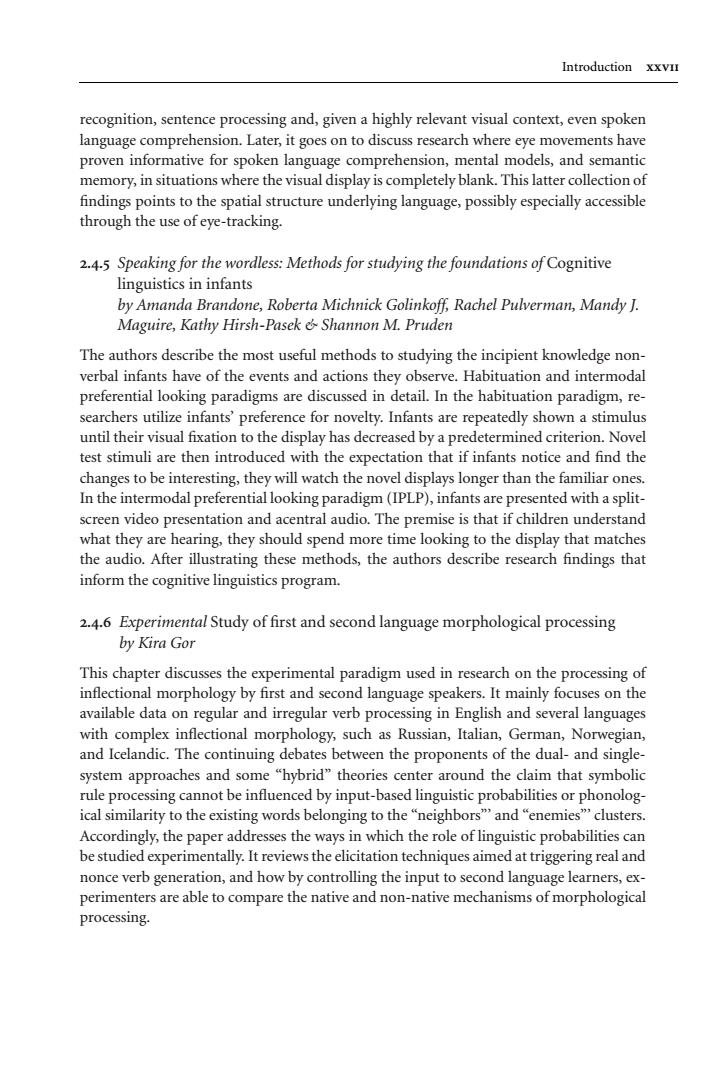正在加载图片...

Introduction XXVII recognition,sentence processing and,given a highly relevant visual context,even spoken language comprehension.Later,it goes on to discuss research where eye movements have proven informative for spoken language comprehension,mental models,and semantic memory,in situations where the visual display is completely blank.This latter collection of findings points to the spatial structure underlying language,possibly especially accessible through the use of eye-tracking. 2.4.5 Speaking for the wordless:Methods for studying the foundations of Cognitive linguistics in infants by Amanda Brandone,Roberta Michnick Golinkoff,Rachel Pulverman,Mandy J. Maguire,Kathy Hirsh-Pasek Shannon M.Pruden The authors describe the most useful methods to studying the incipient knowledge non- verbal infants have of the events and actions they observe.Habituation and intermodal preferential looking paradigms are discussed in detail.In the habituation paradigm,re- searchers utilize infants'preference for novelty.Infants are repeatedly shown a stimulus until their visual fixation to the display has decreased by a predetermined criterion.Novel test stimuli are then introduced with the expectation that if infants notice and find the changes to be interesting,they will watch the novel displays longer than the familiar ones. In the intermodal preferential looking paradigm(IPLP),infants are presented with a split- screen video presentation and acentral audio.The premise is that if children understand what they are hearing,they should spend more time looking to the display that matches the audio.After illustrating these methods,the authors describe research findings that inform the cognitive linguistics program. 2.4.6 Experimental Study of first and second language morphological processing by Kira Gor This chapter discusses the experimental paradigm used in research on the processing of inflectional morphology by first and second language speakers.It mainly focuses on the available data on regular and irregular verb processing in English and several languages with complex inflectional morphology,such as Russian,Italian,German,Norwegian, and Icelandic.The continuing debates between the proponents of the dual-and single- system approaches and some "hybrid"theories center around the claim that symbolic rule processing cannot be influenced by input-based linguistic probabilities or phonolog- ical similarity to the existing words belonging to the "neighbors"and "enemies"clusters. Accordingly,the paper addresses the ways in which the role of linguistic probabilities can be studied experimentally.It reviews the elicitation techniques aimed at triggering real and nonce verb generation,and how by controlling the input to second language learners,ex- perimenters are able to compare the native and non-native mechanisms of morphological processing.JB[v.20020404] Prn:12/04/2007; 9:53 F: HCP18IN.tex / p.6 (372-445) Introduction recognition, sentence processing and, given a highly relevant visual context, even spoken language comprehension. Later, it goes on to discuss research where eye movements have proven informative for spoken language comprehension, mental models, and semantic memory, in situations where the visual display is completely blank. This latter collection of findings points to the spatial structure underlying language, possibly especially accessible through the use of eye-tracking. .. Speaking for the wordless: Methods for studying the foundations of Cognitive linguistics in infants by Amanda Brandone, Roberta Michnick Golinkoff, Rachel Pulverman, Mandy J. Maguire, Kathy Hirsh-Pasek & Shannon M. Pruden The authors describe the most useful methods to studying the incipient knowledge nonverbal infants have of the events and actions they observe. Habituation and intermodal preferential looking paradigms are discussed in detail. In the habituation paradigm, researchers utilize infants’ preference for novelty. Infants are repeatedly shown a stimulus until their visual fixation to the display has decreased by a predetermined criterion. Novel test stimuli are then introduced with the expectation that if infants notice and find the changes to be interesting, they will watch the novel displays longer than the familiar ones. In the intermodal preferential looking paradigm (IPLP), infants are presented with a splitscreen video presentation and acentral audio. The premise is that if children understand what they are hearing, they should spend more time looking to the display that matches the audio. After illustrating these methods, the authors describe research findings that inform the cognitive linguistics program. .. Experimental Study of first and second language morphological processing by Kira Gor This chapter discusses the experimental paradigm used in research on the processing of inflectional morphology by first and second language speakers. It mainly focuses on the available data on regular and irregular verb processing in English and several languages with complex inflectional morphology, such as Russian, Italian, German, Norwegian, and Icelandic. The continuing debates between the proponents of the dual- and singlesystem approaches and some “hybrid” theories center around the claim that symbolic rule processing cannot be influenced by input-based linguistic probabilities or phonological similarity to the existing words belonging to the “neighbors”’ and “enemies”’ clusters. Accordingly, the paper addresses the ways in which the role of linguistic probabilities can be studied experimentally. It reviews the elicitation techniques aimed at triggering real and nonce verb generation, and how by controlling the input to second language learners, experimenters are able to compare the native and non-native mechanisms of morphological processing